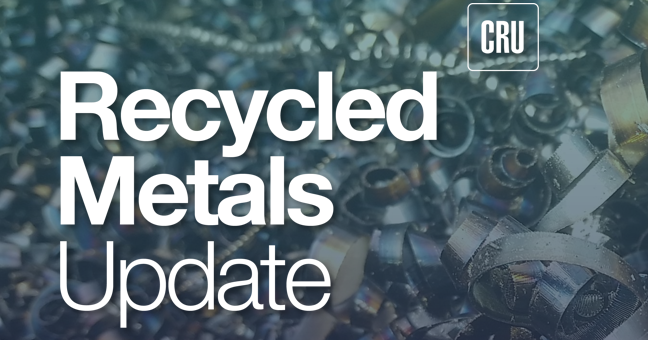Scrap Prices North America

Storms Cloud the Visibility for Scrap
Written by Tim Triplett
September 26, 2017
Pictures of countless cars and trucks submerged in Houston floodwaters and homes shattered by high winds in the Southeast have the worth of a thousand words in describing the destruction from Hurricanes Harvey and Irma. What they say about post-storm conditions in the ferrous scrap market is less clear. For those who assume thousands of scrapped vehicles and home appliances will soon flood the market with material, it’s not that simple, explains scrap guru Mike Marley of the World Steel Exchange Market.
 When unforeseen natural disasters occur, many presume the sudden and unexpected excess of supply will drastically and quickly lower scrap prices. That’s generally not the case.
When unforeseen natural disasters occur, many presume the sudden and unexpected excess of supply will drastically and quickly lower scrap prices. That’s generally not the case.
Vehicles take more time to move into the recycling stream. Following Hurricane Sandy in November 2012, it took several months before cars that were destroyed in northern New Jersey arrived at shredders in the region, recalls Marley, who lost a beloved BMW to the floodwaters.
Drowned cars and trucks don’t go straight to the shredders when they are pulled out of the water. Normally, they first go to auto dismantlers (junkyards, as they used to be called) who pull off the more valuable and easy-to-remove parts such as radiators and catalytic converters. Self-service, pull-a-part yards usually hold vehicles for two or three months and sell reusable parts to small auto repair shops and do-it-yourself mechanics before passing what’s left on to the shredders.
“Cars are beginning to move into the recycling stream, but how soon they will arrive at steel mills and foundries in the form of shredded scrap is uncertain. My guesstimate is maybe December or January,” Marley says. “That will create an odd supply situation since these months are normally the low points, as steel mills buy less scrap and other raw materials at year’s end. Also, scrap yards reduce processing and shipments in the winter months.”
Damaged household and office items can move into the waste stream at a faster pace than water-logged vehicles. Such material typically goes to municipal recycling plants where the metallic items are pulled out and sold to scrap dealers or shredders. Only the larger home appliances and items magnetically separated from the other debris at municipal waste plants ends up in the metal recycling stream. Some, but not all, steel mills will accept it—typically those making rebar or other low-quality products. Some may go to exporters who sell it overseas.
Scrap prices are still a function of supply and demand. Some scrap yards unloaded inventory in anticipation of the storms’ arrival, filling the scrap supply pipelines in the region and depressing prices for obsolete material earlier this month when many expected scrap prices to rise by $20 per ton, Marley says.
The volume of exports of U.S. scrap to foreign mills will also affect the price. If more hurricane-spawned shredded scrap emigrates to Turkey and other offshore mills in India and southern Asia, that could help reduce the anticipated supply overhang, he adds.
Transportation is another issue for the scrap market. Rail, barge and trucking companies may not be able to deliver scrap. Their equipment may have been damaged or their services may be needed more urgently for other storm-related problems.
The potential glut of material from the storms may or may not have a significant effect. “It depends on demand from the different consumers and the offshore markets at the start of 2018,” Marley says. “If the damaged cars and trucks are still flowing at a heavy pace in March and April when the seasonal flows of shredded scrap strengthen, that could have a bigger impact on demand and prices.”
Written by Tim Triplett, Tim@SteelMarketUpdate.com

Tim Triplett
Read more from Tim TriplettLatest in Scrap Prices North America

RMU: The most underappreciated scrap grade
Over the last several years, I have noticed widening spreads between #1 Heavy Melting Steel (ISRI 201) and Shredded (ISRI 210,211), as well as Plate & Structural (ISRI 232).

Domestic scrap tags flat in April
April scrap prices came in sideways in the US, sources told SMU.

RMU: Interest rates, weather hit Radius Recycling’s earnings
Low manufacturing activity and higher interest rates took a toll on Radius Recycling’s profits during the Oregon-based company’s most recent quarter. Radius reported a net loss of $34 million, or $1.19 per share, during its fiscal second quarter. In the previous quarter, Radius saw a net loss of $18 million, or 64 cents per share.

RMU: Northern buyers enter April scrap market sideways
Several large buyers in the North came into the market on a sideways basis from prices paid in March. The development comes after recent speculation about what prices US-based steelmakers would pay for scrap for April shipments.

Miller on scrap: Market seeks direction ahead of April buy
On the eve of the April ferrous scrap buy, there is no firm consensus on the market’s direction. The safe predictions are “soft” sideways to “strong” sideways. That may mean down $10 per gross ton (gt) to up $10/gt.
